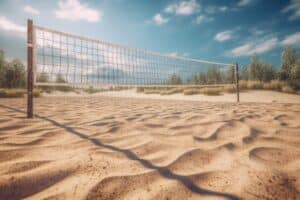How much sand do you need for an outdoor volleyball court?
Key Takeaways
- The size of the volleyball court, the desired depth of the sand, and the type of sand used are the primary factors that affect the amount of sand needed.
- The dimensions of a standard outdoor volleyball court are 60 feet in length and 30 feet in width, but the dimensions can vary depending on specific requirements.
- The recommended depth of sand for an outdoor volleyball court is generally around 12 inches or 30 centimeters.
Building an outdoor volleyball court requires careful planning and preparation. One important aspect of constructing a volleyball court is determining the amount of sand needed. In this article, we will explore the various factors that influence the quantity of sand required and provide you with the information you need to calculate the amount of sand for your outdoor volleyball court.
Factors influencing the amount of sand
The size of the volleyball court, the desired depth of the sand, and the type of sand used are the primary factors that affect the amount of sand needed.
Size of the volleyball court
The dimensions of the volleyball court play a significant role in determining the quantity of sand required. A standard outdoor volleyball court typically measures 60 feet in length and 30 feet in width. However, the dimensions can vary depending on the specific requirements. It is essential to consider the size of the court when calculating the amount of sand needed.
Depth of the sand
The recommended depth of sand for an outdoor volleyball court is generally around 12 inches or 30 centimeters. This depth provides a sufficient cushioning effect and helps prevent player injuries. However, it is important to note that deeper sand may be preferred by some players or in specific competitive settings.
Type of sand
The type of sand used for the volleyball court also influences the quantity required. The most commonly used sand is a clean, well-rounded, and fine-grained sand. This type of sand offers good drainage and provides a stable surface for gameplay. Coarser sands may require more volume to achieve the desired depth.
Calculating the amount of sand
While the specific calculations may vary depending on the factors mentioned above, we can provide a general guideline for estimating the amount of sand needed for a standard-sized outdoor volleyball court.
- Start with the dimensions of the court: 60 feet in length and 30 feet in width.
- Consider the desired depth of the sand. For most cases, a depth of 12 inches is recommended.
- Calculate the volume of sand required using the formula: Length x Width x Depth.
- Convert the volume into the appropriate unit of measurement. For example, if you are using the imperial system, convert cubic feet to tons.
Based on the information provided in the sources, a standard 60×30 feet volleyball court requires approximately 80-100 tons of sand to achieve a depth of 12 inches. However, it is important to note that these numbers are estimates, and the actual amount may vary depending on the factors mentioned earlier.
Tips for leveling the sand
Properly leveling the sand is crucial for ensuring a smooth and consistent playing surface. While the sources do not provide specific tips for leveling sand, here are a few general suggestions:
- Use a long, straight board or a leveling tool to distribute the sand evenly across the court.
- Check the level frequently as you add and spread the sand to ensure an even surface.
- Remove any debris or uneven areas before adding the sand.
- Consider seeking advice from professional court builders or experienced volleyball players for more specific tips on leveling sand.
Conclusion
Constructing an outdoor volleyball court involves careful planning, and determining the amount of sand needed is one crucial aspect of the process. The size of the court, the desired sand depth, and the type of sand used are key factors in calculating the quantity required. While it is challenging to provide an exact figure, the sources suggest that a standard 60×30 feet volleyball court may require approximately 80-100 tons of sand to achieve a depth of 12 inches. However, it is important to consider individual preferences and specific requirements when planning your volleyball court.
Related Websites:
FAQs:
Q: Why are outdoor volleyball courts so popular?
Outdoor volleyball courts are popular because they provide an enjoyable and social activity for people of all ages. Playing volleyball outdoors also offers the benefits of fresh air, sunshine, and the opportunity to connect with nature while exercising.
Q: How does the sand quantity affect gameplay in volleyball courts?
The proper quantity of sand in volleyball courts is crucial for optimal gameplay. It ensures proper cushioning to minimize injuries, allows for proper footwork, and helps absorb player dives and falls, preventing injuries and enhancing overall performance.
Q: What are the preferred qualities of sand for volleyball courts?
Ideal sand for volleyball courts should be clean, with fine grains and minimal impurities. It should also have good drainage and compaction abilities to prevent water accumulation and maintain stability during games.
Q: How often should sand in an outdoor volleyball court be maintained and renewed?
Regular maintenance of the sand in an outdoor volleyball court is essential. It should be leveled to ensure an even playing surface, and debris such as leaves or twigs should be removed regularly. Sand may need replenishment every 1-2 years, depending on usage and weather conditions.
Q: Why is it important to ensure the correct amount of sand for an outdoor volleyball court?
Having the correct amount of sand is important to maintain the integrity and quality of the volleyball court. Insufficient sand can lead to an uncomfortable playing surface, increased risk of injuries, and compromised gameplay experience. It is crucial to follow the recommended sand quantity guidelines for optimal performance.






